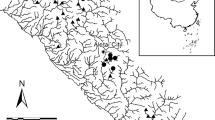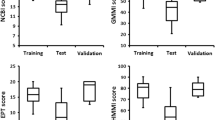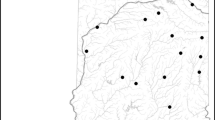Abstract
Diatoms and macroinvertebrates are both commonly used for biological assessment of stream condition. As the use of biological assessment techniques increases, resource managers will need to make decisions on which biological tool to use for a particular study. In a study of the Kiewa River, Victoria, Australia we assessed these two components of the biota—macroinvertebrates and diatoms—using indices and pattern analysis, and comparing them with an a priori landscape classification. We also assessed the relationship exhibited between the biological results and environmental variables which are usually significant in stream ecosystems. To make the data comparable we used categorical abundances for both data sets. The pattern analyses showed complementary results, with diatoms more closely related to water quality variables, whereas macroinvertebrates were primarily related to catchment and habitat features. An analysis of a combined data set (diatoms plus macroinvertebrates) showed no extra information was gained. Using categorisation to create consistency between data sets was shown to reduce the information and affect results from the diatom analyses. The results suggested that the locally derived bioassessment models and indices provided a more accurate assessment of the sites than the overseas-derived diatom index. The outcomes are complicated by issues of data weighting, whereby a presence/absence diatom index may have performed better than abundance-weighted indices due to strong dominance of one or two species at a site. Future comparisons will benefit from an increase in the knowledge of regional diatom taxonomy and autecology.
Similar content being viewed by others
References
APHA, 1995. American Public Health Association, American Water Works Association, & Water Environment Federation. Standard Methods for the Examination of Water and Wastewater, 19th edn. American Public Health Association, Washington, DC, USA
Barbour M. T., Plafkin J. L., Bradley B. P., Graves C. G. and Wisseman R. W. (1992). Evaluation of EPA’s rapid bioassessment benthic metrics: metric redundancy and variability among references stream sites. Environmental Toxicology and Chemistry 11: 437–449
Barton J. L. and Metzeling L. (2004). The development of biological objectives for streams in a single catchment: a case study on the catchment of Western Port Bay, Victoria, Australia. Environmental Monitoring and Assessment 95: 239–256
Battarbee R. (1986). Diatom analysis. In: Berglund, B. (eds) Handbook of Holocene Palaeoecology and Palaeohydrology, pp. John Wiley and Sons Ltd, Chichester, U.K
Belbin, L. 1993. PATN: Pattern analysis package. Technical reference, Belbin, L., CSIRO. Division of Wildlife and Ecology, Canberra, Australia
Biggs B. and Lowe R. (1994). Responses of two trophic levels to patch enrichment along a New Zealand stream continuum. New Zealand Journal of Marine and Freshwater Research 28: 119–134
Chessman B. C. (1986). Dietary studies of aquatic insects from two Victorian rivers. Australian Journal of Marine and Freshwater Research 37: 129–146
Chessman B. C. (1995). Rapid assessment of rivers using macroinvertebrates: a procedure based on habitat-specific sampling, family level identification and a biotic index. Australian Journal of Ecology 20: 122–129
Chessman B. C. (2003). New sensitivity grades for Australian river macroinvertebrates. Marine and Freshwater Research 54: 95–103
Chessman, B., N. Bate, P. Gell, P. Newall, (in prep.). Development of diatom-based tools for assessing stream water quality in south eastern Australia: a new species-level biotic index
Clarke K. R. (1993). Non-parametric multivariate analyses of changes in community structure. Australian Journal of Ecology 18: 117–143
Coimbra C. N., Graca M. A. S. and Cortes R. M. (1996). The effects of a basic effluent on macroinvertebrate community structure in a temporary Mediterranean river. Environmental Pollution 94: 301–307
Cranston P. S., 1996. Identification guide to the Chironomidae of New South Wales. Identification Guide Number 1, Cranston, P.S., AWT Ensight, Sydney, Australia
Davies P. E. (2000). Development of a national river bioassessment system (AUSRIVAS) in Australia. In: Wright, J. F., Sutcliffe, D. W. and Furse, M. T. (eds) Assessing the biological quality of freshwaters: RIVPACS and other techniques, pp 113–124. Freshwater Biological Association, Ambleside, Cumbria, UK
Davis J. A. (1986). Boundary layers, flow microenvironments and stream benthos. In: Williams, W. D. (eds) Limnology in Australia, pp 555–72. CSIRO, Melbourne and Junk Publishers, Dordrecht, The Netherlands
DeShon J. E. (1995). Development and application of the invertebrate community index (ICI). In: Davis, W. S. and Simon, T. P. (eds) Biological Assessment and Criteria, pp. CRC Press, Florida, USA
Doeg T. J., Davey G. W. and Blyth J. D. (1987). Response of the aquatic macroinvertebrate communities to dam construction on the Thomson River, southeastern Australia. Regulated Rivers: Research & Management 1: 195–209
(1989). Water Victoria: A Resource Handbook. Department of Water Resources, Victoria, Australia
EPA 1995. Protecting water quality in the Yarra catchment, Publication 471, Environment Protection Authority Victoria, Australia
Fluin J. (1998). Degradation of alpine streams: diatoms as biological indicators. In: Newall, P. (eds) The First Australian Diatom Workshop: Proceedings, pp 24–40. Technical Paper 1998/1, Deakin University School of Ecology and Environment, Clayton, Victoria, Australia
Gasse, F., (1986). East African diatoms: taxonomy, ecological distribution. Bibliotheca Diatomologica Vol. 2. Cramer, Berlin
Gell P. (1997). The development of a diatom database for inferring lake salinity, western Victoria, Australia: towards a quantitative approach for reconstructing past climates. Australian Journal of Botany 45: 389–423
Gregory S. (1983). Plant-herbivore interactions in stream systems. In: Barnes, J. R. and Minshall, G. W. (eds) Stream Ecology: Application and Testing of General Ecological Theory, pp 157–189. Plenum Press, New York
Hall R. and Smol J. (1992). A weighted averaging regression and calibration model for inferring total phosphorus concentration from diatoms in British Columbia (Canada) lakes. Freshwater Biology 27: 417–434
Hellawell J. M. (1986). Biological Indicators of Freshwater Pollution and Environmental Management. Elsevier, London
Hynes, H. B. N., 1978. An annotated key to the nymphs of the stoneflies (Plecoptera) of the state of Victoria. Hynes, H. B. N. (ed), Australian Society for Limnology Special Publication No.2, University of Tasmania Press, Hobart, Australia
Krammer K and Lange-Bertalot H. (1986). Bacillariophyceae. 2(1). Teil: Naviculaceae. In: Ettl, H., Gerloff, J., Heynig, H. and Mollenhauer, D. (eds) Süsswasserflora von Mitteleuropa, pp. Gustav Fischer Verlag, Stuttgart
Krammer K. and Lange-Bertalot H. (1988). Bacillariophyceae. 2(2). Teil: Bacillariaceae, Epithemiaceae, Surirellaceae. In: Ettl, H., Gerloff, J., Heynig, H. and Mollenhauer, D. (eds) Süsswasserflora von Mitteleuropa, pp. Gustav Fischer Verlag, Stuttgart
Krammer K and Lange-Bertalot H. (1991a). Bacillariophyceae. 2(3). Teil: Centrales, Fragilariaceae, Eunotiaceae. In: Ettl, H., Gerloff, J., Heynig, H. and Mollenhauer, D. (eds) Süsswasserflora von Mitteleuropa, pp. Gustav Fischer Verlag, Stuttgart
Krammer K and Lange-Bertalot H. (1991b). Bacillariophyceae. 2(4). Teil: Achnanthaceae; Kritische Ergänzungen zu Navicula (Lineolatea) and Gomphonema. In: Ettl, H., Gerloff, J., Heynig, H. and Mollenhauer, D. (eds) Süsswasserflora von Mitteleuropa, pp. Gustav Fischer Verlag, Stuttgart
Kutka F. and Richards C. (1996). Relating diatom assemblage structure to stream habitat quality. Journal of the North American Benthological Society 15: 469–480
(1977). Report on the Alpine Study Area. Land Conservation Council, Melbourne
Lecointe C., Coste M. and Prygiel J. (1993). “Omnidia”: software for taxonomy, calculation of diatom indices and inventories management. Hydrobiologia 269/270: 509–513
Lenoir, A. & M. Coste, 1996. Development of a practical diatom index of overall water quality applicable to the French national water board network. In Whitton, B. A. & E. Rott (eds), Use of Algae in Monitoring Rivers II. Institut für Botanik, Universität Innsbruck, 29–43.
Marchant R. (1989). Changes in the benthic invertebrate communities of the Thomson river, southeastern Australia, after dam construction. Regulated Rivers: Research & Management 4: 71–89
Marchant R. (1990). Robustness of classification and ordination of techniques applied to macroinvertebrate communities from the La Trobe River, Victoria. Australian Journal of Marine and Freshwater Research 41: 493–504
Marchant R., Metzeling L., Graesser A. and Suter P. (1985). The organisation of macroinvertebrate communities in the major tributaries of the LaTrobe River, Victoria, Australia. Freshwater Biology 15: 315–331
Marchant R., Barmuta L. A. and Chessman B. C. (1994). Preliminary study of the ordination and classification of macroinvertebrate communities from running waters in Victoria, Australia. Australian Journal of Marine and Freshwater Research 45: 945–962
Metzeling L. (1993). Benthic macroinvertebrate community structure in streams of different salinities. Australian Journal of Marine and Freshwater Research 44: 335–351
Metzeling L., Graesser A., Suter P. and Marchant R. (1984). The distribution of aquatic macroinvertebrates in the uppr catchment of the LaTrobe River, Victoria. Occasional Papers from the Museum of Victoria 1: 1–62
Metzeling L., Doeg T. and O’Connor W. (1995). The impact of salinisation and sedimentation on aquatic biota. In: Bradstock, R. A., Auld, T. D., Kieth, D. A., Kingsford, R. T., Lunney, D., and Siversten, D. P. (eds) Conserving Biodiversity: Threats and Solutions, pp. Surrey Beatty & Sons, Australia
Metzeling, L., D. Tiller, P. Newall, F. Wells & J. Reed (this issue) Biological Objectives For The Protection Of Rivers And Streams In Victoria, Australia. Hydrobiologia
Newall P., Bate N., (2002). Diatoms as biomonitors in the Kiewa River system. In John J. (ed.), Proceedings of the 15th International Diatom Symposium, 1998, Charles Sturt University, Perth
Newall P. and Tiller D. (2002). Derivation of nutrient guidelines for streams in Victoria, Australia. Environmental Monitoring & Assessment 74: 85–103
Newall P and Walsh C. (2005). Response of epilithic diatom assemblages to urbanisation influences. Hydrobiologia 532: 53–67
Norris R. H. and Georges A. (1986). Design and analysis for assessment of water quality. In: Williams, W. D. (eds) Limnology in Australia, pp 555–72. CSIRO Melbourne and Junk Publishers, Dordrecht, The Netherlands
Norris R. H. and Norris K. R. (1995). The need for biological assessment of water quality: an Australian perspective. Australian Journal of Ecology 20: 1–6
Norris R. H. and Thoms M. C. (1999). What is river health?. Freshwater Biology 41(2): 197–210
Pan Y., Stevenson R., Hill B., Herlihy A. and Collins G. (1996). Using diatoms as indicators of ecological conditions in lotic systems: a regional assessment. Journal of the North American Benthological Society 15: 481–495
Parnrong S. and Campbell I. C. (1997). Two new species of Austrophlebiodes Campbell and Suter (Ephemeroptera: Leptophlebiidae) from Australia, with notes on the genus. Journal of Entomology 36: 121–127
Patrick, R, & C. Reimer, 1966. The Diatoms of the United States exclusive of Alaska and Hawaii, Vol. 1: Fragilariaceae, Eunotiaceae, Achnanthaceae, Naviculaceae. Monographs of the Academy of Natural Sciences of Philadephia, No 13. The Academy of Natural Sciences of Philadephia, Philadelphia, USA
Peters W. L. and Campbell I. C. (1991). Ephemeroptera. In: Division of Entomology, CSIRO (eds) The Insects of Australia, pp 279–293. Melbourne University Press, Melbourne, Australia
Plafkin, J. L., M. T. Barbour, K. D. Porter, S. K. Gross & R. M. Hughes, 1989. Rapid bioassessment protocols for use in streams and rivers: benthic macroinvertebrates and fish. U.S. Environmental Protection Agency (EPA/444/4-89-001)
Prygiel J. and Coste M. (1993). The assessment of water quality in the Artois-Picardie water basin (France) by the use of diatom indices. Hydrobiologia 269/270: 343–349
Reynoldson T. B., Bailey R. C. and Norris R. H. (1995). Biological guidelines for freshwater sediment based on BEnthic Assessment of SedimenT (the BEAST) using a multivariate approach for predicting biological state. Australian Journal of Ecology 20: 198–219
Rosenberg D. M. and Resh V. H. (1993). Introduction to freshwater biomonitoring and benthic macroinvertebrates. In: Rosenberg, D. M. and Resh, V. H. (eds) Freshwater Biomonitoring and Benthic Macroinvertebrates, pp 1–9. Chapman and Hall, New York
Simpson, J. & R. H. Norris, 2000. Biological assessment of river quality: development of AUSRIVAS models and outputs. In: Assessing the biological quality of fresh waters. RIVPACS and other techniques. Freshwater Biological Association, Ambleside, Cumbria, UK
Sloane P. I. W. and Norris R. H. (2003). Relationships of AUSRIVAS-based macroinvertebrate predictive model outputs to a metal pollution gradient. Journal of the North American Benthological Society 22: 457–471
Smith M. J., Kay W. R., Edward D. H. D, Papas P. J., Richardson K., Simpson J. C., Pinder A. M., Cale D. J., Horwitz P. H. J., Davis J. A., Yung F. H., Norris R. H. and Halse S. A. (1999). AusRivAS: using macroinvertebrates to assess ecological condition of rivers in Western Australia. Freshwater Biology 41: 269–282
Sonneman, J., A. Sincock, J. Fluin, M. Reid, P. Newall, J. Tibby & P. Gell, 2000. An Illustrated Guide to Common Stream Diatom Species from Temperate Australia. Murray Darling Freshwater Research Centre Identification Guide Series, Guide No. 33, Cooperative Research Centre for Freshwater Ecology, Albury, Australia
Sonneman J., Walsh C., Breen P. and Sharpe A. (2001). Effects of urbanization on streams of the Melbourne region, Victoria, Australia. II. Benthic diatom communities. Freshwater Biology 46: 553–565
St Clair R. M. (1994). Diets of some larval Leptoceridae (Trichoptera) in South-eastern Australia. Australian Journal of Marine and Freshwater Research 45: 1023–1032
Tiller, D. & L. Metzeling, 1998. Rapid Bioassessment of Victorian Streams: the Approach and Methods of the Environment Protection Authority. EPA Publication 604, Environment Protection Authority Victoria, Australia
Turak E., Flack L. K., Norris R. H., Simpson J. and Waddell N. (1999). Assessment of river condition at a large spatial scale using predictive models. Freshwater Biology 41: 283–298
Mertens A. (1995). Long-term changes of diatoms and chemistry in headwater streams polluted by atmospheric deposition of sulphur and nitrogen compounds. Freshwater Biology 34: 579–600
Mertens A. and Sinkeldam J. (1994). A coded checklist and ecological indicator values of freshwater diatoms from the Netherlands. Netherlands Journal of Aquatic Ecology 28: 117–133
Watanabe, T., K. Asai & A. Houki, 1986. Numerical water quality monitoring of organic pollution using diatom assemblages. Proceedings of the 9th International Diatom Symposium, Bristol, August 24–30, 1986
Wright I. A., Chessman B. C., Fairweather P. G. and Benson L. J. (1995). Measuring the impact of sewage effluent on the macroinvertebrate community of an upland stream: the effect of different levels of taxonomic resolution and quantification. Australian Journal of Ecology 20: 142–149
Wright J., Furse M. and Armitage P. (1993). RIVPACS - a technique for evaluating the biological quality of rivers in the U.K. European Water Pollution Control 3: 15–25
Author information
Authors and Affiliations
Corresponding author
Rights and permissions
About this article
Cite this article
Newall, P., Bate, N. & Metzeling, L. A comparison of diatom and macroinvertebrate classification of sites in the Kiewa River system, Australia. Hydrobiologia 572, 131–149 (2006). https://doi.org/10.1007/s10750-006-0263-4
Received:
Revised:
Accepted:
Published:
Issue Date:
DOI: https://doi.org/10.1007/s10750-006-0263-4




